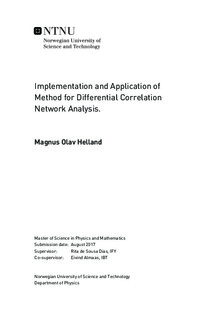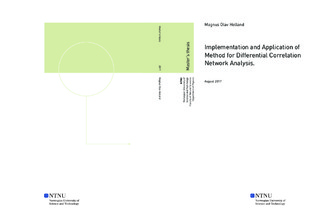| dc.description.abstract | A novel framework for differential co-expression networks have recently been developed at the Department of Biotechnology and Food Science at the Norwegian University of Science and Technology (NTNU). The method, referred to as the CSD-framework, aims to conserve more information about the co-expression patterns in the analyzed gene-expression data than other existing methods, by separating between three different forms of differential co-expression; conserved (C), specific (S), and diverging (D). As a contribution to this project, a new program, CSD-CS, for fast and easy generation of differential co-expression networks using the CSD-framework, was developed in this thesis. The entire software has been implemented, tested, and analyzed as part of this thesis, and are described in chapters 3 and 4.
An application of the software, and a corresponding network analysis, were performed to illustrate the full scope of the differential co-expression network methodology. The analysis were performed on real-life gene-expression data from rheumatoid arthritis (RA) patients, and a healthy control group. The analysis identified biology with known association to the disease-state, such as immune system and inflammation related biology. It also identified the genes CD5, CCL21 and CCR6 in the network, which has been associated with RA. Additionally, enrichment of genes related to PRDM1 and TYK2, two other RA-associated genes were identified. Finally, the analysis identified several genes with possible RA-related functions, including CD72, FOXD1, AP8B2 and HAPLN4, which could be interesting to analyze further.
Some of the findings from the analysis did not have any known relation to the disease state. The CSD-method is designed to only capture co-expression patterns related to genes that are tightly co-regulated across all patients, in at least one of the data-sets. It is therefore reasonable to assume that the constructed network captures only essential and/or disease related expression-patterns. This means that the network provides a good basis for generating hypotheses about RA, and that the findings with unknown disease-relevance may point to biology with currently undiscovered or indirect association to RA. | |

